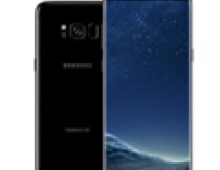
Galaxy S8 Materials Costs More Than Any Previous Versions, Teardown Reveals
The new Samsung Galaxy S8 equipped with 64 gigabytes (GB) of NAND flash memory carries a bill of materials (BOM) cost that comes out to US$301.60, much higher than for previous versions of the company's smartphones.
According to a preliminary estimate from IHS Markit, after $5.90 in basic manufacturing costs are added, Samsung's total cost to make the Galaxy S8 rises to $307.50; the unsubsidized price for a 64GB Galaxy S8 starts at around $720. The preliminary estimated total at this point is $43.34 higher than that of the Galaxy S7 previously performed by IHS Markit, and is $36.29 higher than the total build cost of the Galaxy S7 Edge, considered a better comparison to the Galaxy S8.
Both the Galaxy S8 and S8 Plus feature a 10-nanometer (nm) system-on-chip (SoC) along with CAT-16 LTE modem and radio. The CDMA version of the S8, intended for use in the United States as well as in China, will feature the Snapdragon 835 chipset from Qualcomm. In comparison, a version of the phone featuring Samsung's homegrown Exynos 8895 chipset will be used for the rest of the world.
The CAT-16 LTE radio allows the new Galaxy phone to aggregate three carriers of up to 20 megahertz each. Combined with 4x4 MIMO antennas and higher-order modulation of 256 QAM, the LTE modem is capable of reaching peak theoretical speeds of one gigabit per second.
The redesigned Galaxy S8 has a tall, narrow shape that is 1.5 millimeters narrower than the previous Galaxy S7, providing slick new ergonomics while also optimizing screen real estate. The screen curves around the edges, and Samsung designers have maximized the display, relative to the size of the phone, with a 5.8-inch 2960x1440 AMOLED display and an elongated aspect ratio of 18.5:9. Compared to conventional 16:9 aspect-ratio Quad HD smartphone displays, the Galaxy S8 features an additional 15 percent more pixels in a form factor that is easier to hold in the hand. The device's haptic engine, which provides the "click" feel for users, also has been improved for longer-duty cycles and a more dynamic response.
Both the Galaxy S8 and S8 Plus feature 4GB of RAM and built-in storage of 64GB - twice the standard built-in storage found in the Galaxy S7 as well as the iPhone 7. Storage for the new Samsung phones can also be expanded, up to 256GB, via a microSD card. The Samsung NAND flash memory and DRAM on the S8 come in at a cost of $41.50.
The battery capacity on the Galaxy S8, at 3000 milliamp hour (mAh), is the same as that found in last year's Galaxy S7. However, compared to the Galaxy S7 Edge, which had a 3600mAh battery, Samsung played it safe after the Note 7 incident and included a considerably less dense battery pack. Overall cost estimate for the Galaxy S8 battery pack is $4.50.
Although the Galaxy S8 and S8 Plus come with new features and the latest components, each still has only a single camera in the back - essentially the same as the camera module found in last year's Galaxy S7. Apple's iPhone 7 Plus, the newly launched LG G6 and many Chinese OEMs are now promoting dual cameras as a key feature. Owing to the asymmetric placement of the rear fingerprint sensor, it would have been likely that a dual-camera design was scrapped at the last minute in the design cycle.




















